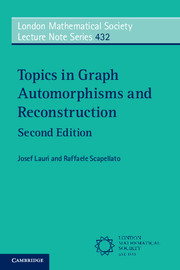Book contents
- Frontmatter
- Dedication
- Contents
- Preface to the Second Edition
- Preface to the First Edition
- 1 Graphs and Groups: Preliminaries
- 2 Various Types of Graph Symmetry
- 3 Cayley Graphs
- 4 Orbital Graphs and Strongly Regular Graphs
- 5 Graphical Regular Representations and Pseudosimilarity
- 6 Products of Graphs
- 7 Special Classes of Vertex-Transitive Graphs and Digraphs
- 8 The Reconstruction Conjectures
- 9 Reconstructing from Subdecks
- 10 Counting Arguments in Vertex-Reconstruction
- 11 Counting Arguments in Edge-Reconstruction
- References
- List of Notations
- Index of Terms and Definitions
5 - Graphical Regular Representations and Pseudosimilarity
Published online by Cambridge University Press: 05 June 2016
- Frontmatter
- Dedication
- Contents
- Preface to the Second Edition
- Preface to the First Edition
- 1 Graphs and Groups: Preliminaries
- 2 Various Types of Graph Symmetry
- 3 Cayley Graphs
- 4 Orbital Graphs and Strongly Regular Graphs
- 5 Graphical Regular Representations and Pseudosimilarity
- 6 Products of Graphs
- 7 Special Classes of Vertex-Transitive Graphs and Digraphs
- 8 The Reconstruction Conjectures
- 9 Reconstructing from Subdecks
- 10 Counting Arguments in Vertex-Reconstruction
- 11 Counting Arguments in Edge-Reconstruction
- References
- List of Notations
- Index of Terms and Definitions
Summary
We have seen that the full automorphism group of a Cayley graph Cay(Γ, S) can be larger than Γ. If it happens that Aut(Cay(Γ, S)) is in fact equal to Γ, then, by Theorem 3.5, the automorphism group of Cay(Γ, S) acts regularly on V(Cay(Γ, S)). Conversely, if G is a graph whose automorphism group acts regularly on V(G), then G is a Cayley graph. (This follows from the second part of Theorem 3.5 and also from Sabidussi's Theorem because the stabiliser H in that theorem is trivial.)
A graph G whose automorphism group Γ = Aut(G) acts regularly on V(G) is called a graphical regular representation (GRR) of the group Γ. Therefore G is a GRR of its automorphism group Γ if it is vertex-transitive and the stabiliser Γv of any vertex is just the identity.
Note that in this case, by the Orbit-Stabiliser Theorem, |V(G)| = |Γ|. Also, given any two vertices u, v in G, there is one and only one automorphism α such that α(u) = v. Also, G − u has a trivial automorphism group for any vertex u.
Elementary results
Let us first consider the question of what conditions a graph must satisfy in order to be a GRR of its automorphism group. For convenience we shall state in the next theorem the main comments that we made in the introduction to this chapter, noting again that its proof follows from Theorem 3.5 or Sabidussi's Theorem.
Theorem 5.1Let G be a GRR of its automorphism group Γ. Then G is isomorphic to a Cayley graph Cay(Γ, S) for some set S that generates the group Γ.
Not any Cayley graph is, however, a GRR.
Lemma 5.2Let G = Cay(Γ, S) and let ϕ be an automorphism of Γ such that ϕ(S) = S. Then ϕ, as a permutation of V(G) = Γ, is an automorphism of G fixing the vertex 1.
Therefore, if ϕ is nontrivial, then G is not a GRR.
Proof Since ϕ is a group automorphism, ϕ(1) = 1. Also, ϕ is a graph automorphism Because
These results therefore imply that, for G to be a GRR, it (i) must be isomorphic to a Cayley graph Cay(Γ, S) and (ii) no nontrivial automorphism of Γ can fix the set S.
- Type
- Chapter
- Information
- Topics in Graph Automorphisms and Reconstruction , pp. 79 - 91Publisher: Cambridge University PressPrint publication year: 2016

